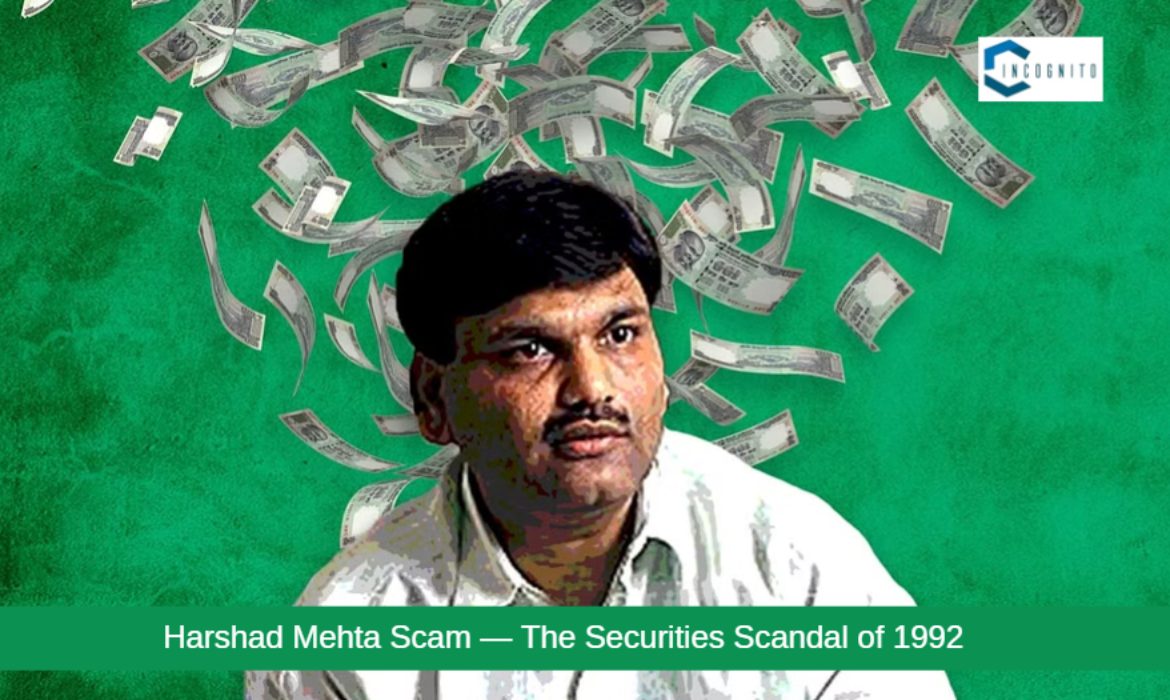
Introduction
As a common man, we need to understand the financial scams. Everything in our daily lives relates to our economy in any way. The financial system changes with the buying and selling habits of the people of the country, so, there is a connection between the financial system and our buying and selling habits which signifies we are the foundation of the economy. So it is very essential to understand the financial market and how the financial market operates. How the financial scams are on of the most harmful factor for any economy and how the financial scams give rise to unevenness in the economy? Let’s try to acknowledge every aspect of 1992 in detail with its impact on the Indian Economy and how the stock market was undergone a big collision due to this.
The 1992 Indian stock market scam is one of the well-known and immense scam ever taken place in the Indian Stock Market. In 1992 Scam, Harshad Mehta, Brokers and Banks tricked the whole Indian economic system.
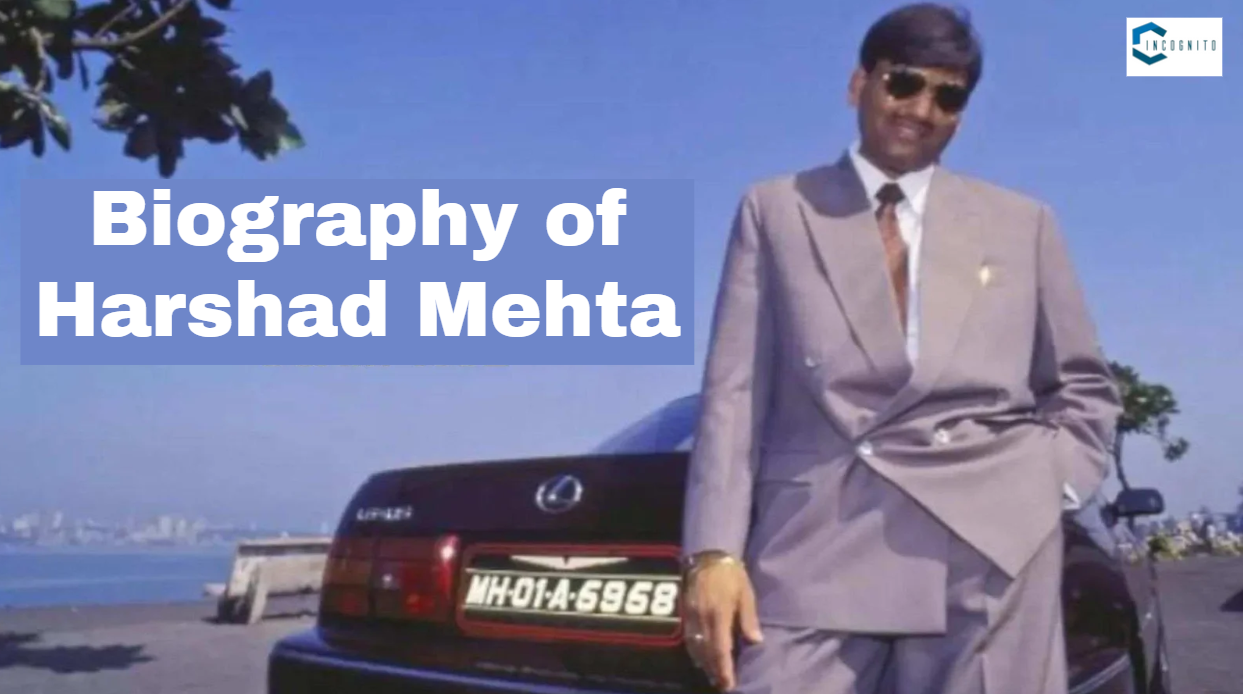
Biography of Harshad Mehta
Biography of Harshad Mehta
Harshad Shantilal Mehta was an Indian stock broker, born into Gujarati Jain Family on 29 July 1954 and spent his early years in Kandivali. His father operated a modest textile firm.
He was a cricket lover, and upon finishing his schooling he moved to Mumbai for further studies and to get a job. In 1976, he earned his B.Com degree from Lala Lajpatrai College, Mumbai and in the early years, he took on several odd jobs including sales of hosiery, cement, diamonds, and other items. During his time working as a salesperson at New Delhi India Assurance Company Limited (NIACL), he developed an interest in the Stock Market, then he quit that job and got into a brokerage firm to gain more knowledge about the stock market he started working under Prasann Pranjivandas broker, whom he regarded as his “Mentor”.
After working for various brokerage companies and earning expertise, Harshad Mehta became a member of the Bombay Stock Exchange (BSE) as a broker by building his brokerage company, ‘Grow More Research and Asset Management,’ in 1984. He began actively trading in 1986. Through the 10 years, by 1990 he gained a noteworthy position in the stock market. Media and famous magazines like “Business Today” began calling him the “Big Bull of Dalal Street” and “The Amitabh Bachan of the stock market”.
He acquired more than 20 cars, some of which are very costly and imported from foreign countries like the Lexus LS 400. He had a book value of around 3542 crores and a lavish house of 15,000 square feet in Mumbai’s Worli with a mini-golf course and swimming pool. Considering everything, he used to live a lavish life which people could only imagine.
So Harshad Mehta was a stockbroker who gained so much wealth by tricking the stock markets in a way that had never be done before. Let’s discover how he did this.
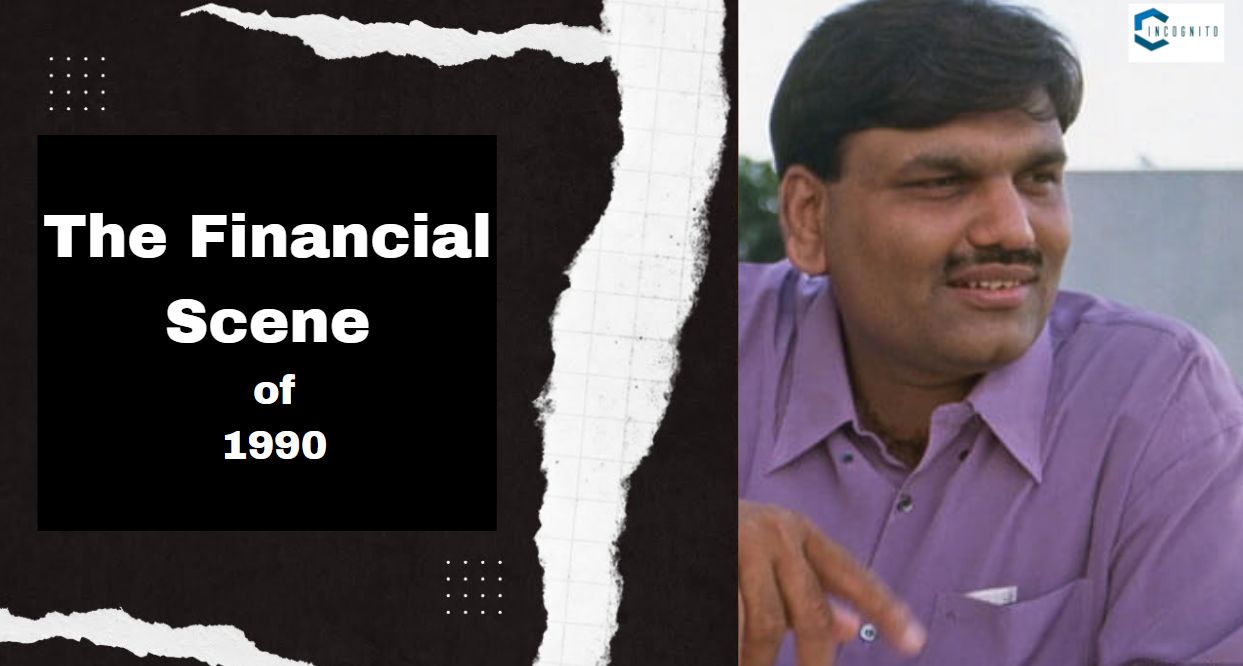
The Financial Scene of 1990
The Financial Scene of 1990
Economic liberalization was introduced by the Indian Government in 1991. At that time, the public sector was pushed to battle high competition and was under pressure to demonstrate profitability in the new era of liberalization, but the private sector reacted positively to this change. At that time, there was an elevation in demand for capital. For this reason, the banks were forced to take benefit of this situation to upgrade their financial performance, together with this banks were also pressured to maintain profitability. Banks were not authorized to participate in the stock market, therefore banks were not capable to make the use of stock market to get advantage during 1991.
Financial Terms associated with the events of the Security Scam of 1992
Before we discuss the actual scam, it will be more effective for us to understand the scam in more detail if get to acknowledge some of the financial terms, related to Scam 1992.
Statutory Liquidity Ratio (SLR) – It’s compulsory for the banks to maintain a specific entry (in the 1990’s it was fixed to 38.5%) of government fixed-rate bonds. The minimal percentage of government bonds which banks have to keep is known as Statutory Liquidity Ratio (SLR).
Ready Forward (RF) Deal – A ready-forward loan is a loan for a short period from one bank to another, commonly for 15 days or shorter. It’s similar to one bank selling its securities to another with the bond of repurchasing them at a specific price.
Bank Receipt (BR) – The borrowing bank in place of providing the securities (the government bonds) provided a BR which was validation that money is received and if a default occurs securities will be provided. So BR is like “I Owe You (IOU)” receipt.
Why BR, Not the Securities – The reason is, that the bond certificate held by the bank would amount to 100 Crore, but the prerequisite of the banks to keep their SLR ratio would be lower. So, BRs were the easy method of short-term transactions, Br’s were utilized so that the actual transfer of securities did not occur. BRs could easily be cancelled and given back when the deal was executed.
Settlement Cycle – It is a timeframe for brokers to pay for and take delivery of stocks or deliver sold stocks. The government allocates bonds intending to enhance the nation’s infrastructure, these bonds capitalize on the major development projects undertaken by the government.
Roles Performed By Brokers
Brokers in the market performed the role of mediator among two banks in the RF deal system, by aiding borrowing banks to meet lending banking. The banks were supposed to handle and control trading securities and payments, but brokers soon discovered a method to play a big role. As a consequence, all the transactions of securities and payments were done to brokers, and banks also approved and accepted this due to several reasons:
Liquidity: Brokers offered a fast and convenient replacement as compared to dealing with another bank.
Confidentiality: Lending banks were uninformed as to where the loans were being transferred to and the borrowing banks were not bothered about the origin of loans.
Credibleness: As brokers were managing the settlement procedure which favoured the borrowing banks as they could have loans obtainable regardless of their credibleness.
The loans were considered as loans to the brokers and loans from the brokers.
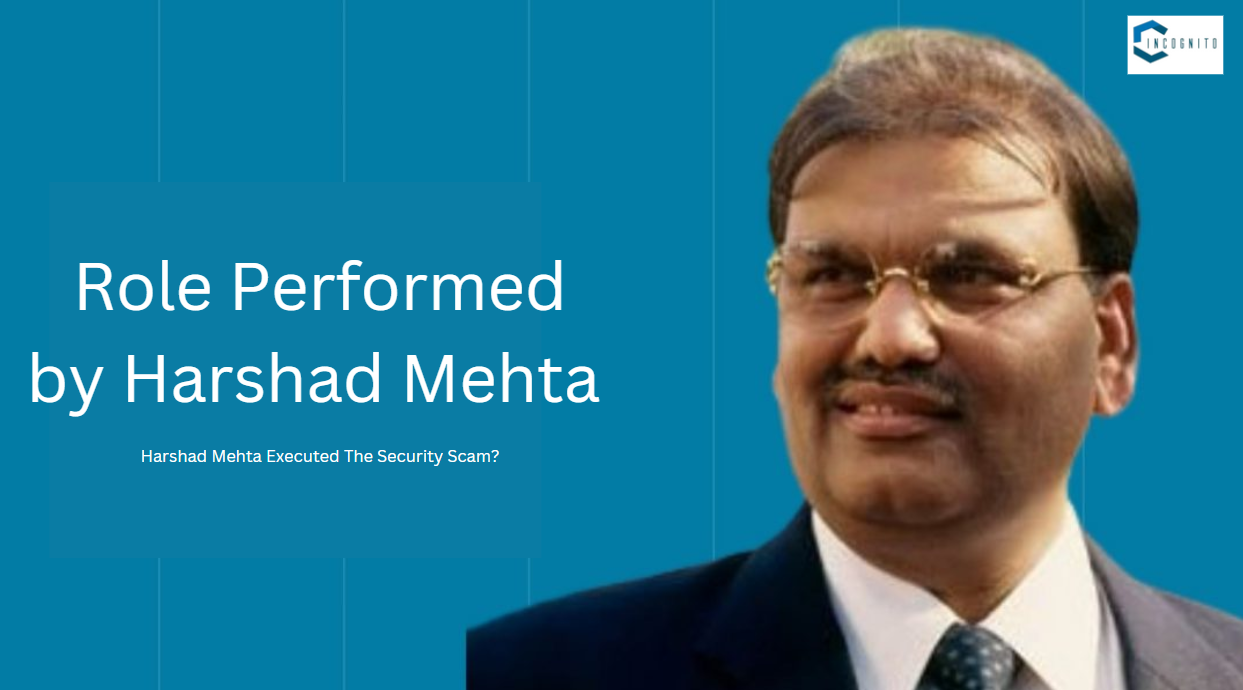
Role Performed by Harshad Mehta
Role Performed by Harshad Mehta – How Harshad Mehta Executed The Security Scam?
Harshad Mehta was experienced in handling the RF transactions. He convinced the banks to issue cheques in his name. He then transferred the money that had been deposited in his account in the stock market. He took benefit of the loophole in the system and elevated the scam to another level.
Only two banks can be included in a normal RF transaction. Securities would be taken from a bank in return for funds. But, when a bank asked for security or payback, Harshad Mehta would take help from a third bank. Ultimately, there will be a fourth, fifth, Sixth bank, and so on. In place of just two banks, there were a sudden so many of them, all associated with a chain of RF transactions.
How Harshad Mehta Executed the Security Scam? – Let’s Learn More About The Scam
Harshad Mehta utilized the money, he obtained from the banks to battle with the bear cartels in the stock market. Bear Cartels were also running the stock market with capital that they defrauded from the banks to navigate the market minus to minimize the stocks and securities. Responding to this Harshad Mehta was driving the money from the banks which was deposited in his account into the stock market to continue the demand high in the market. He had acquired a prominent place in the stock market that everyone trusts his words blindly.
Some of the Well Known Stock Controlled by Harshad Mehta –
As Harshad Mehta was investing money which was deposited in his account into the stock market, where he controlled shares of some companies such as ACC, Videocon, and Sterlite Industries and just made these companies’ shares to accelerate the demand suddenly. He then started to sell those shares and returned the money to banks and deposited the profits in bank account.
He invested in various companies like ACC, Apollo Tyres, Reliance, Hero Honda, Tata Iron and Steel Co (TISCO), BPL, Sterlite and Videocon, which resulted in the sudden rise in Sensex. In the time between April 1991 to April 1992, the Sensex yielded 274%, from 1194 points to 4467, which is the topmost compound growth rate.
Benefits to Banks – Were Banks Well Informed?
The banks were well informed of Harshad Mehta’s scams but banks continued the silence as they were also gaining profit from the earnings which Harshad Mehta was generating from the stock market, which was supporting banks to sustain profitability.
The Fraud Within The Fraud
Fake BR Scam – Harshad honed the skill of using fake BRs to get unsecured loans from the banking systems, as he observed it very quickly the reliance of RF Deals on BRs. To get the fake BRs he approached some microscale and less-known banks such as The Bank of Karad (BOK) and The Metropolitan Cooperative Bank (MCB), to issue the BR as and when needed. With the support of these two banks, he successfully forged the BRs which were not favoured by securities – which signifies they were just papers with no actual value. And later he invested all this money into the stock market.
Fake Government Bonds – Also to get rid of the collateral he falsified government bonds themselves. However, this falsification resulted in only a small amount of swindled funds.
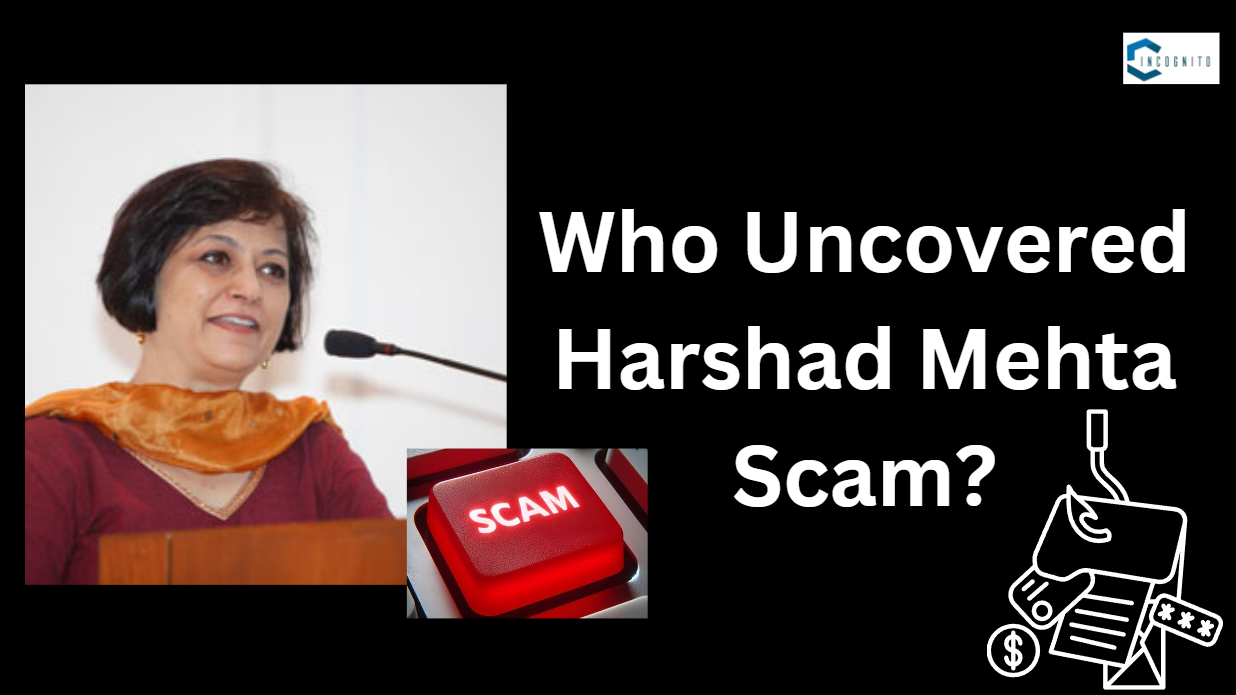
Sucheta Dalal
Who Uncovered Harshad Mehta Scam?
Journalist Sucheta Dalal uncovered the scam on 23rd April 1992 in an article in The Times of India. Moreover, in the investigation and evaluation conducted by RBI, the values displayed by BR in circulation were notably higher than the government bonds held by the banks. Sucheta Dalal became interested after she observed him arriving at the State Bank of India offices. Also, the Bear Cartel, working towards ending Mehta’s Bullish run, teamed up against him and reported his activities.
The scam’s revelation gave rise to the suicide of the chairman of Vijaya Bank who issued a check to Mehta. Harshad Mehta was sentenced by the Bombay High Court and the Supreme Court of India for his involvement in this monetary scam valued at Rs 5000 crore.
After the revelation of this scam, the stock market collapsed and most of the investors faced heavy losses. Also, banks asked Harshad to return their money, but due to the Bear run, Harshad failed to return the money. Securities and Exchange Board of India (SEBI) even disallowed him completely from trading in the stock market.
After the scam was revealed, Harshad Mehta was thrown in jail by the Central Bureau of Investigation (CBI) in November 1992. He was imposed with 600 civil action suits and 70 criminal cases. After spending three months in jail, he managed to get released with the help of Ram Jethmalani. However, in 1997, he was arrested again and sent to Thane jail.
The Impact of the Harshad Mehta Scam on Dalal Street
The scam revealed the inconsistency in the Indian Banking System, and Bombay Stock Exchange (BSE) transaction system and SEBI further established new regulations to cover these inconsistencies.
Harshad Mehta changed the approach of the stock market and the way brokers trade following the fraud, the Securities Regulations (Amendments) Act was imposed in 1995, which broadened the jurisdiction of the Securities and Exchange Board of India. It enabled SEBI to supervise depositories, FIIS, venture capital funds, and credit rating agencies.
Here are five ways the Indian stock markets have transformed since 1992 Scam –
Settlement Cycle – In 1992 the period was 14 days, Now, it has been reduced to two days.
Minimum Balance – In 1992, there was no law over maintaining the minimum balance in an account that a consumer requires to make sure to buy stocks. Now, a consumer can’t buy stocks without maintaining a minimum balance in a bank account or sell in the absence of stocks in their Demat account.
Trading Procedure – Before 1992, all the trades were conducted through dealers on paper, which carried a significant execution risk. Now, consumers are executing their trades independently.
Settlement of Trades – Before 1992, settlement of trades were executed via paper, which exposed counterparties to risk. Today, all transactions are electronic, trade settlement are managed via clearing corporations only.
Brokerage Fee – In 1992, customers had to pay at least 1% as a brokerage for equity delivery trades. Today, no brokerage charges are implemented.
Final Words
The Harshad Mehta scam can be viewed from two perspectives. One sees it as Mehta tricking the stock market, banks, and the public. The other perspective displays Mehta as victim, diverting attention away from other powerful figures. Some financial experts argue that Mehta didn’t commit any scam or fraud but rather make the use of inadequacy in the system.
Read More:
Stock Market Crashed On Monday: Here’s What You Need To Know



